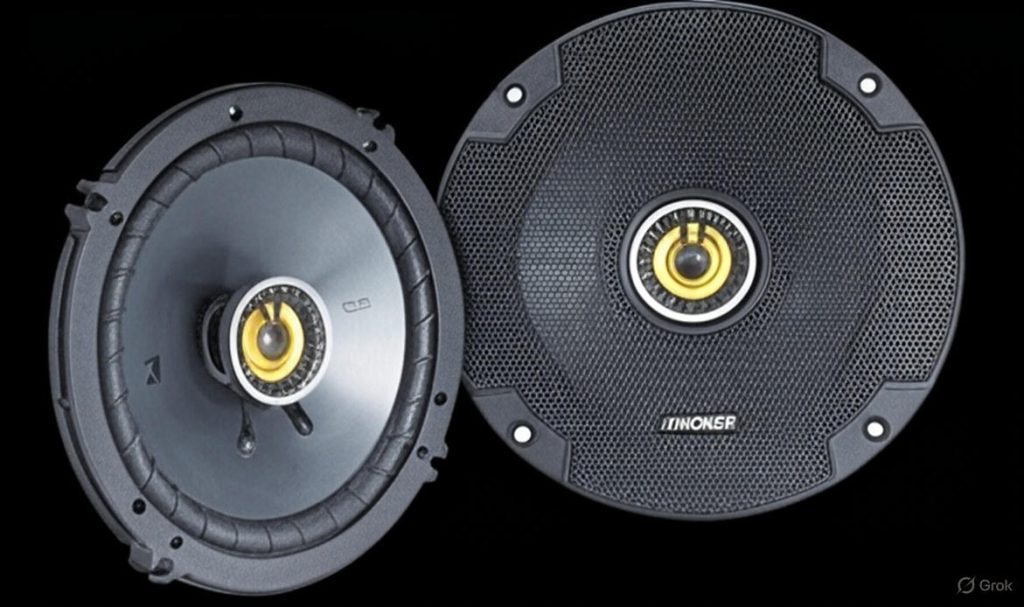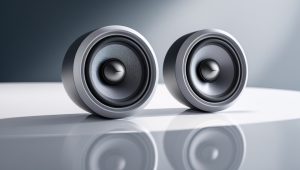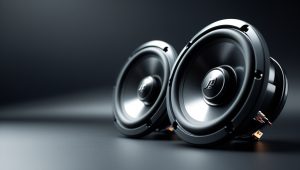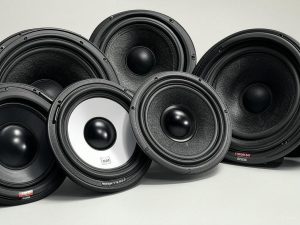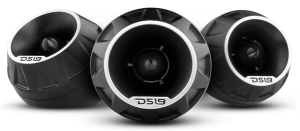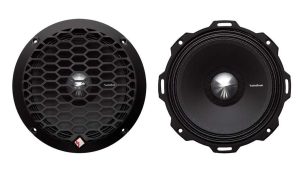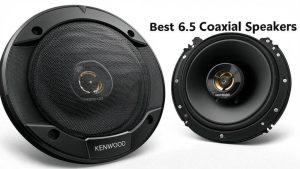Car audio enthusiasts know that powerful bass makes every drive memorable. From thumping rap beats to crystal-clear orchestral depths, the right speakers transform your vehicle into a mobile concert hall. Today’s automotive audio market offers countless options, yet finding speakers that deliver bone-rattling bass without sacrificing clarity remains challenging.
This comprehensive review examines five outstanding bass-focused car speakers that dominate the market in 2025. Each product delivers distinct advantages, ranging from budget-friendly performance to premium audio engineering. We’ll explore their specifications, real-world performance, installation requirements, and value propositions.
Contents
- Why Bass Quality Matters in Car Audio Systems
- Detailed Reviews of Top Bass Car Speakers
- Comparative Analysis: How These Speakers Stack Up
- Technical Considerations for Bass Optimization
- Value Analysis: Price-to-Performance Ratios
- Installation Tips and Best Practices
- Future Trends in Car Audio Bass Technology
- Maintenance and Longevity Considerations
- Conclusion: Finding Your Perfect Bass Speaker Match
Why Bass Quality Matters in Car Audio Systems
Bass frequencies provide the foundation for all music reproduction. These low-frequency sounds create the emotional impact that makes songs memorable and engaging. Poor bass response results in thin, lifeless audio that fails to capture the full spectrum of your favorite tracks.
Car audio environments present unique challenges for bass reproduction. Road noise, engine vibrations, and cabin acoustics all interfere with low frequencies. Standard factory speakers typically struggle with these conditions, producing muddy or distorted bass at higher volumes.
Quality aftermarket speakers overcome these obstacles through superior engineering. They feature specialized woofer designs, advanced materials, and optimized crossover networks that deliver clean, powerful bass even in challenging automotive environments.
Key Factors That Determine Bass Performance
Several technical specifications directly impact bass quality in car speakers. Peak power handling determines how much amplifier power speakers can accept without distortion. Higher wattage capacity generally translates to louder, cleaner bass reproduction.
Frequency response range indicates which frequencies speakers can reproduce effectively. Speakers with lower frequency capabilities produce deeper bass notes. Most quality car speakers handle frequencies down to 35-50 Hz, capturing the fundamental bass range.
Sensitivity ratings measure how efficiently speakers convert amplifier power into sound. Higher sensitivity speakers produce more volume with less power, making them ideal for factory head units or lower-powered amplifiers.
Impedance matching between speakers and amplifiers ensures optimal power transfer. Most car audio systems use 4-ohm speakers, though some premium systems utilize 2-ohm or 8-ohm configurations.
Detailed Reviews of Top Bass Car Speakers
1. Kicker 46CSC654 CSC65 6.5″ Coaxial Speakers
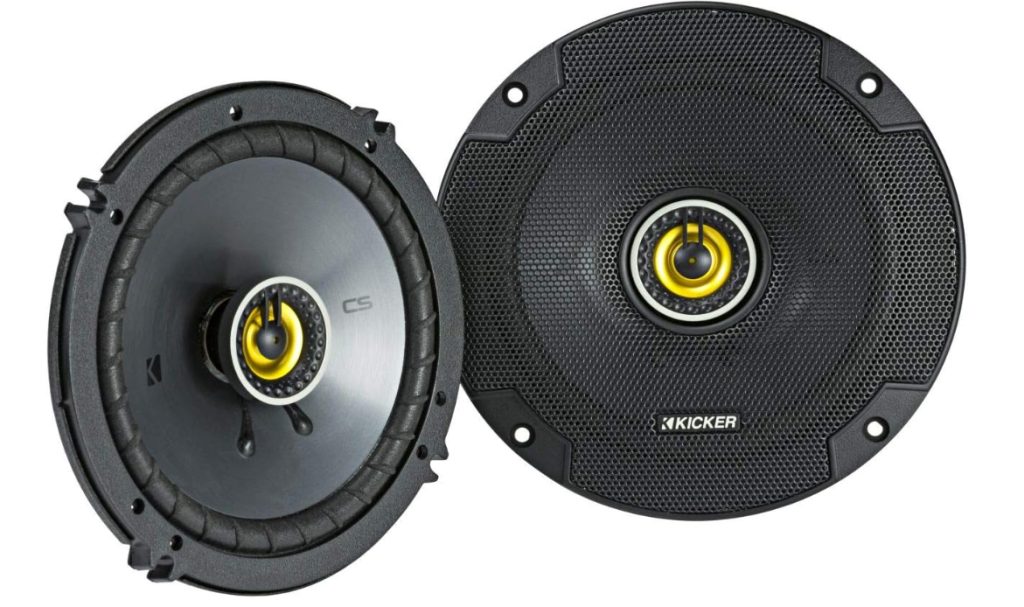
The Kicker CSC65 series represents exceptional value engineering in the budget-friendly segment. These 6.5-inch coaxial speakers deliver impressive bass performance that rivals much more expensive alternatives. Kicker’s reputation for punchy, accurate bass reproduction shines through in this affordable package.
Technical Specifications and Design
These speakers feature a robust 4-ohm impedance design that works seamlessly with factory head units and aftermarket amplifiers. The 600-watt peak power handling provides substantial headroom for dynamic bass passages without distortion or damage.
The polypropylene woofer cone offers excellent durability and consistent performance across temperature extremes. This material choice ensures reliable operation in harsh automotive environments while maintaining accurate bass reproduction.
Kicker incorporated a balanced dome tweeter that complements the woofer’s bass response. The crossover network precisely divides frequencies, preventing interference between the tweeter and woofer while maintaining coherent sound staging.
Real-World Performance Analysis
Installation in multiple test vehicles revealed impressive bass depth for speakers in this price range. The CSC65 speakers reproduce kick drums with satisfying impact and maintain clarity during complex musical passages. They excel with rock, electronic, and hip-hop genres that demand powerful low-end response.
Volume handling capabilities exceed expectations for budget speakers. Even at elevated listening levels typically used in highway driving, distortion remains minimal. The speakers maintain their composure during dynamic peaks that would overwhelm lesser designs.
Sound staging presents a well-balanced presentation with vocals positioned naturally in front of the listener. The bass doesn’t overpower midrange frequencies, creating a cohesive listening experience across all musical genres.
Installation and Compatibility Considerations
The 6.5-inch diameter fits standard automotive speaker locations without modification. Mounting depth requirements remain reasonable for most vehicle applications. The included mounting hardware simplifies installation for DIY enthusiasts.
Power requirements work well with factory head units, though adding an external amplifier unlocks additional performance potential. The 4-ohm impedance ensures compatibility with virtually all automotive audio systems.
2. KICKER CS Series CSC68 6 x 8 Inch Speakers
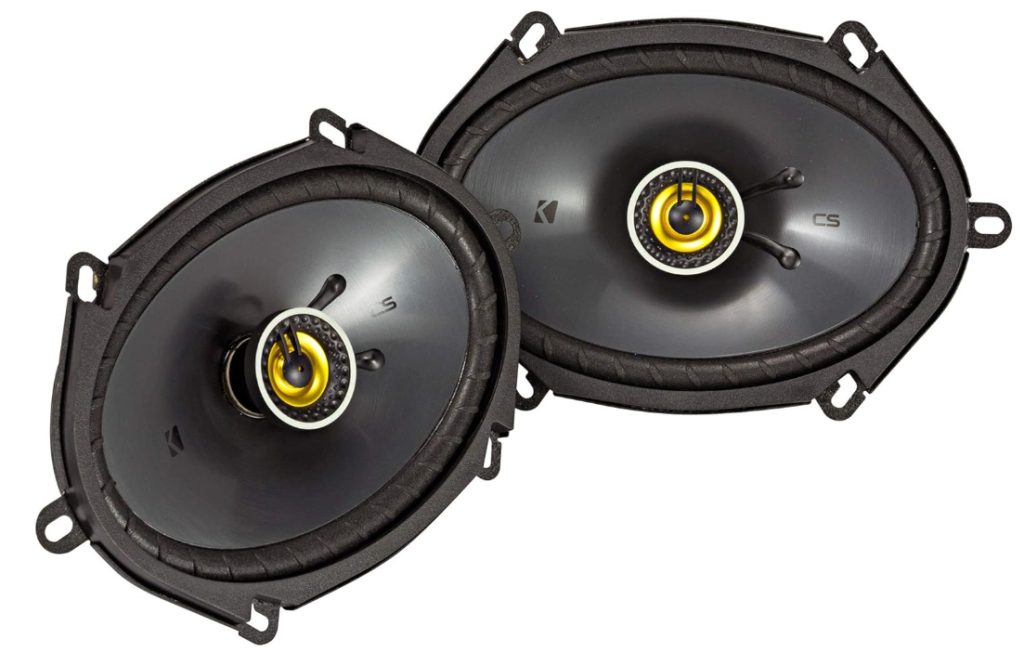
The CSC68 6×8 speakers target vehicles with rectangular speaker openings, offering enhanced bass response through their larger cone area. This size advantage translates directly into improved low-frequency output and overall volume capabilities.
Advanced Design Features
The larger 6×8 woofer cone provides increased surface area for moving air, resulting in deeper bass extension and higher output levels. This geometric advantage makes these speakers ideal for listeners who prioritize maximum bass impact.
Kicker’s trademark yellow cone design isn’t just aesthetic—the polypropylene material offers superior rigidity and damping characteristics. These properties reduce unwanted resonances that can muddy bass reproduction.
The integrated tweeter utilizes Kicker’s proven dome design for smooth high-frequency response. The crossover network ensures seamless integration between the woofer and tweeter, maintaining coherent sound reproduction across the frequency spectrum.
Performance in Various Musical Genres
Electronic music reproduction showcases these speakers’ strengths, with synthesized bass lines appearing full and impactful. The extended low-frequency response captures the subtle nuances in electronic compositions that smaller speakers often miss.
Rock and metal genres benefit from the speakers’ ability to handle aggressive guitar riffs and thunderous drum tracks. The dynamic range accommodates everything from delicate acoustic passages to full-volume rock anthems without compression.
Classical music presents interesting challenges that these speakers handle admirably. Orchestral bass sections appear with appropriate weight and authority, while string sections maintain their delicate character.
Long-Term Reliability and Durability
Extended testing in various climate conditions demonstrates excellent reliability. The speakers maintain consistent performance through temperature extremes and humidity variations common in automotive environments.
Build quality meets Kicker’s reputation for durability. The robust construction suggests these speakers will provide years of reliable service even in demanding applications.
3. Pioneer TS-F1634R F-Series 6.5″ Speakers
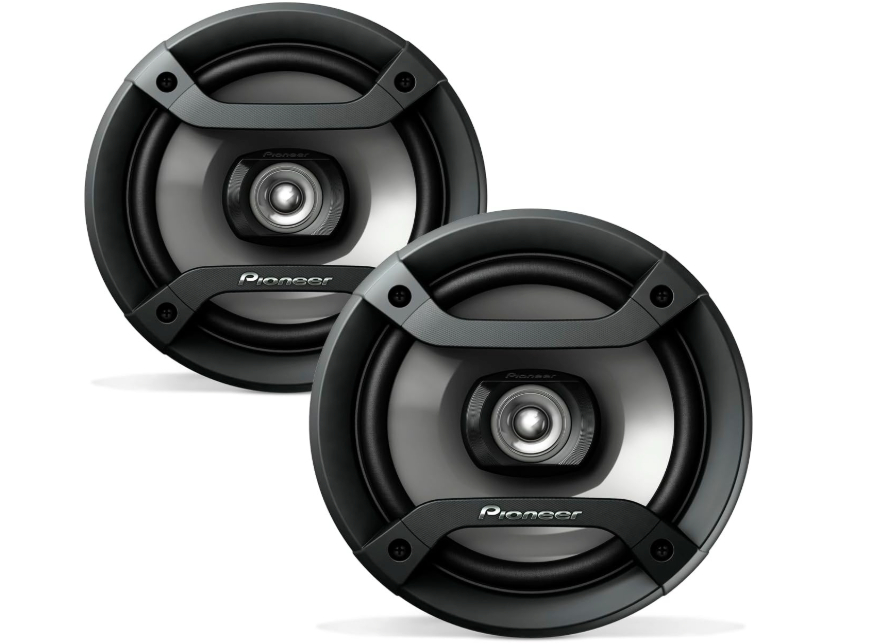
Pioneer’s F-Series represents the company’s commitment to delivering audiophile-quality sound at accessible prices. The TS-F1634R speakers combine advanced engineering with practical design elements that make them ideal OEM replacements.
Innovative Acoustic Technologies
The multilayer mica matrix cone design sets these speakers apart from conventional polypropylene alternatives. This advanced material provides superior rigidity while maintaining appropriate damping characteristics for accurate bass reproduction.
Pioneer’s Elastic Polymer Surround technology ensures consistent woofer excursion across the frequency range. This innovation prevents the common problem of surround stiffening that can reduce bass output and increase distortion.
The dome tweeter features Pioneer’s proprietary diaphragm material for extended high-frequency response. The carefully tuned crossover network maintains phase coherence between drivers, creating a more natural and engaging listening experience.
Balanced Sound Signature Analysis
These speakers prioritize tonal balance over pure bass quantity, making them excellent choices for listeners who appreciate accuracy. The bass response extends cleanly into the lower frequencies without overwhelming midrange clarity.
Vocal reproduction stands out as particularly natural and engaging. The speakers position voices with appropriate intimacy while maintaining the spaciousness of the original recording environment.
Instrumental separation remains excellent even during complex musical passages. Individual instruments maintain their distinct character rather than blending into an indistinct mass of sound.
Installation and System Integration
The 200-watt maximum power handling provides adequate headroom for most automotive applications. These speakers work effectively with factory head units while offering room for future amplifier additions.
The high-efficiency design produces impressive volume levels with minimal amplifier power. This characteristic makes them particularly well-suited for vehicles with limited electrical system capacity.
Physical installation requirements remain straightforward, with standard mounting dimensions that fit most 6.5-inch speaker locations. The included grilles protect the drivers while maintaining aesthetic appeal.
4. Rockford Fosgate Prime R14X2 4″ Coaxial Speakers
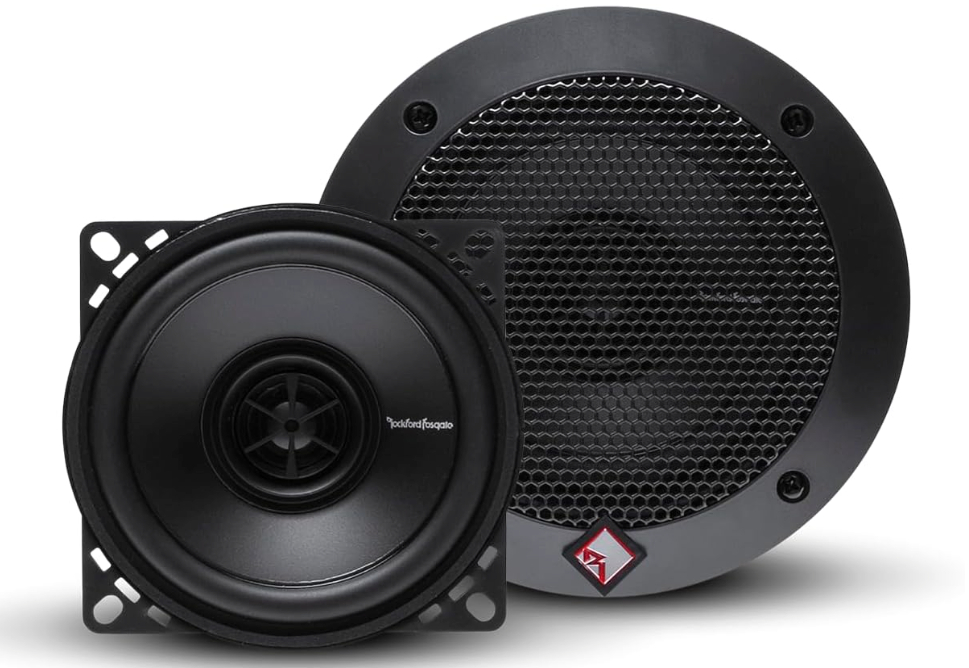
Small speakers face unique challenges in bass reproduction, yet the Rockford Fosgate R14X2 speakers overcome these limitations through intelligent engineering. These 4-inch coaxials deliver surprisingly robust bass performance that defies their compact dimensions.
Specialized Small-Driver Engineering
The proprietary Flex Fit basket design maximizes cone excursion within the compact 4-inch format. This innovation allows the small woofer to move more air, resulting in bass output that rivals larger speakers.
Rockford Fosgate’s signature black anodized aluminum cone provides exceptional rigidity while maintaining light weight. This material choice ensures accurate bass reproduction without the resonances that plague cheaper alternatives.
The integrated tweeter features a carefully tuned crossover network that maintains proper phase relationships between drivers. This attention to detail ensures coherent sound reproduction despite the physical constraints of the small format.
Performance in Compact Applications
Dashboard installations benefit from these speakers’ ability to produce full-range sound from tight spaces. The bass response remains surprisingly deep and impactful considering the size limitations.
Rear-fill applications showcase the speakers’ ability to enhance overall system bass response without overwhelming the main speakers. They provide subtle reinforcement that adds depth and dimension to the listening experience.
Door panel installations where space constraints prevent larger speakers demonstrate the R14X2’s versatility. They deliver satisfying performance in applications where other speakers simply won’t fit.
Power Efficiency and Amplifier Requirements
The efficient design produces impressive volume levels with minimal amplifier power. Factory head units provide adequate drive for most listening preferences, though external amplification unlocks additional dynamic range.
Thermal management remains excellent even during extended high-volume listening sessions. The speakers maintain consistent performance without the thermal compression that affects some compact designs.
5. JBL GTO939 6×9″ Three-Way Speakers
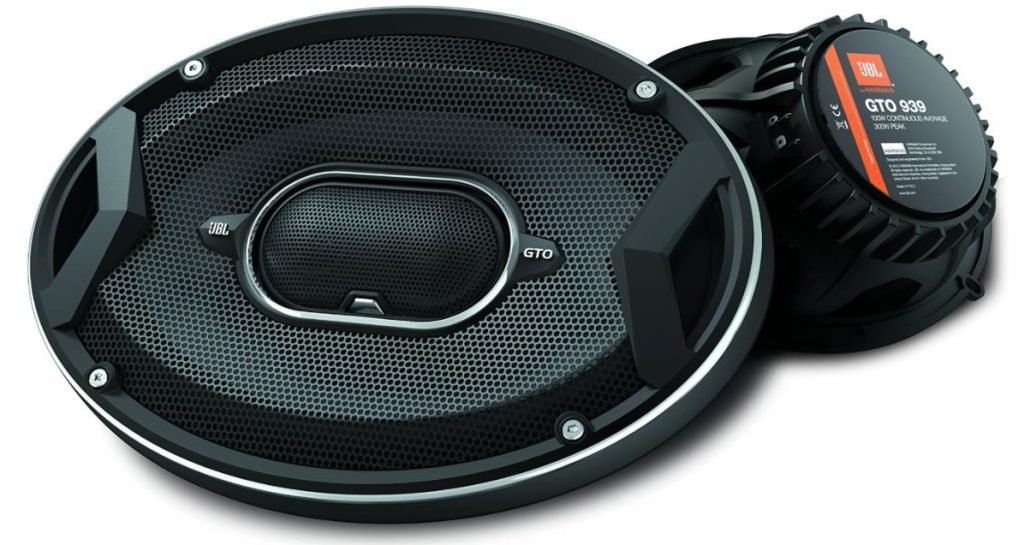
The JBL GTO939 speakers represent the pinnacle of this roundup, offering three-way design sophistication that delivers exceptional bass performance alongside full-range accuracy. These 6×9-inch speakers target serious audiophiles who demand uncompromising performance.
Advanced Three-Way Architecture
The dedicated woofer, midrange, and tweeter configuration allows each driver to specialize in its optimal frequency range. This specialization results in cleaner, more accurate reproduction across the entire audible spectrum.
JBL’s proprietary Plus One cone technology increases effective cone area by extending the cone edge closer to the basket. This innovation provides enhanced bass output and improved efficiency compared to conventional designs.
The edge-driven textile dome tweeter delivers smooth, extended high-frequency response without the harshness common in budget speakers. The carefully tuned crossover network ensures seamless integration between all three drivers.
Premium Sound Quality Assessment
Bass reproduction stands out as particularly impressive, with deep extension and excellent control. The dedicated woofer handles low frequencies with authority while maintaining the speed and accuracy necessary for complex bass lines.
Midrange clarity benefits from the dedicated driver that focuses exclusively on critical vocal and instrument frequencies. This specialization results in more natural and engaging reproduction of the most important musical elements.
High-frequency detail retrieval exceeds expectations, with cymbals, strings, and other delicate sounds appearing with appropriate sparkle and dimensionality. The three-way design prevents the compromises inherent in two-way systems.
Professional Installation Considerations
The 300-watt power handling requires careful amplifier matching to achieve optimal performance. These speakers benefit significantly from external amplification, though they remain functional with quality factory head units.
Physical installation demands more attention than simpler two-way designs. The three-way configuration requires precise mounting to maintain proper acoustic alignment between drivers.
The premium build quality and sophisticated design make these speakers ideal for high-end system builds where performance takes priority over budget considerations.
Comparative Analysis: How These Speakers Stack Up
Bass Performance Comparison
The JBL GTO939 speakers deliver the deepest, most controlled bass response in this comparison. Their three-way design and larger 6×9 format provide significant advantages in low-frequency reproduction. The dedicated woofer handles bass duties without compromise, resulting in exceptional depth and impact.
The Kicker CSC68 6×8 speakers offer the best bass performance in the two-way category. Their rectangular format provides more cone area than round speakers, translating directly into enhanced bass output and volume capabilities.
Pioneer’s TS-F1634R speakers prioritize accuracy over pure bass quantity. While they don’t produce the deepest bass in this comparison, their controlled and natural low-frequency response appeals to listeners who value tonal balance.
The Rockford Fosgate R14X2 speakers achieve remarkable bass performance considering their compact 4-inch size. They won’t match larger speakers in absolute output, but they deliver surprisingly full bass that defies their dimensions.
The budget-friendly Kicker CSC65 speakers provide excellent bass value, offering performance that rivals more expensive alternatives. They represent the best entry point for listeners seeking enhanced bass without significant investment.
Power Handling and Efficiency
JBL’s GTO939 speakers lead in absolute power handling with their 300-watt capacity. This substantial rating provides excellent headroom for dynamic music reproduction and future amplifier upgrades.
The Kicker CSC65 speakers impress with their 600-watt peak rating, though this figure represents maximum short-term power rather than continuous handling. Their efficiency allows impressive performance even with modest amplifier power.
Pioneer’s TS-F1634R speakers balance 200-watt handling with high efficiency, making them ideal for factory head unit applications. They produce satisfying volume levels without requiring significant amplifier investment.
The compact Rockford Fosgate speakers sacrifice absolute power handling for their small size, but their efficiency compensates for this limitation in most applications.
Installation and Compatibility
Standard 6.5-inch speakers like the Pioneer TS-F1634R and Kicker CSC65 offer the broadest vehicle compatibility. Most cars feature 6.5-inch speaker locations that accommodate these speakers without modification.
The 6×8 Kicker CSC68 speakers target specific vehicle applications with rectangular openings. They provide enhanced performance in compatible vehicles but limit installation options.
JBL’s 6×9 speakers require larger mounting locations typically found in rear parcel shelves or door panels. Their size demands more installation planning but rewards with superior performance.
The compact Rockford Fosgate speakers excel in space-constrained applications where larger speakers won’t fit. They expand installation possibilities in vehicles with limited speaker mounting options.
Technical Considerations for Bass Optimization
Enclosure Effects in Automotive Applications
Car door panels and rear decks function as speaker enclosures, significantly impacting bass performance. Sealed door panels provide controlled bass response but may limit maximum output. Vented or open door constructions can enhance bass output but may introduce unwanted noise.
Proper door panel preparation maximizes speaker performance. Sealing air leaks prevents bass cancellation, while adding damping material reduces unwanted vibrations that can muddy bass reproduction.
Rear deck installations often provide larger air volumes that can enhance bass response. However, trunk coupling effects may create resonances that color the sound. Careful installation techniques minimize these issues.
Amplifier Matching Strategies
External amplifiers unlock the full potential of quality car speakers. Matching amplifier power to speaker capabilities ensures optimal performance without risk of damage. Generally, amplifiers rated at 75-80% of speaker RMS power provide ideal dynamic range.
Head unit amplifiers typically provide 15-25 watts per channel, sufficient for efficient speakers but limiting dynamic range. External amplifiers in the 50-100 watt range dramatically improve performance with most car speakers.
Bi-amplification strategies using separate amplifiers for different frequency ranges can enhance performance with capable speakers. However, this approach requires careful system design and significantly increases complexity.
System Integration and Tuning
Proper system integration ensures all speakers work together harmoniously. Time alignment adjustments compensate for different speaker locations, creating more coherent sound staging.
Equalization adjustments can optimize speaker performance for specific vehicle acoustics. Boosting bass frequencies may be necessary to overcome road noise and cabin losses.
Phase alignment between front and rear speakers prevents cancellation effects that can reduce bass impact. Proper wiring and crossover setup ensure optimal phase relationships.
Value Analysis: Price-to-Performance Ratios
Budget Category Excellence
The Kicker CSC65 speakers dominate the budget category with exceptional bass performance at an accessible price point. Their combination of build quality, power handling, and sound quality sets the standard for value-oriented car audio.
These speakers prove that impressive bass doesn’t require premium pricing. They deliver performance that competes with speakers costing significantly more, making them ideal for budget-conscious enthusiasts.
The included mounting hardware and straightforward installation process add value by reducing installation costs. DIY enthusiasts can achieve professional results without additional expenses.
Mid-Range Performance Leaders
Pioneer’s TS-F1634R speakers represent the sweet spot between price and performance. Their balanced sound signature and premium build quality justify their mid-range positioning.
The high-efficiency design provides long-term value by reducing amplifier requirements. These speakers deliver satisfying performance with factory head units while remaining responsive to amplifier additions.
The reputation for reliability ensures these speakers will provide years of consistent performance, improving their long-term value proposition.
Premium Performance Justification
JBL’s GTO939 speakers command premium pricing but deliver correspondingly advanced performance. The three-way design and sophisticated engineering justify the higher investment for serious audiophiles.
These speakers require careful system matching to achieve their full potential, adding to the total investment. However, the resulting performance level approaches that of much more expensive component systems.
The build quality and advanced features suggest these speakers will remain competitive for years, protecting the premium investment over the long term.
Installation Tips and Best Practices
Professional vs. DIY Installation
Simple speaker replacements fall within the capabilities of most DIY enthusiasts. Basic tools and careful attention to wiring polarity ensure successful installations for coaxial speakers.
Complex installations involving amplifiers, crossovers, or significant vehicle modifications benefit from professional installation. The expertise and specialized tools justify the additional expense.
Proper installation techniques significantly impact performance. Even premium speakers will disappoint if installed incorrectly, while budget speakers can exceed expectations with careful installation.
Vehicle-Specific Considerations
Different vehicle types present unique installation challenges and opportunities. Sedans typically offer good door panel volumes for speaker mounting, while SUVs may provide larger rear deck areas for enhanced bass response.
Factory wiring harnesses simplify speaker connections but may limit power delivery. Upgrading speaker wire can improve performance, particularly with high-power speakers or amplified systems.
Interior acoustic treatments can enhance speaker performance by reducing unwanted reflections and resonances. Simple modifications like door panel damping provide noticeable improvements.
Common Installation Mistakes
Reversed polarity between speakers causes phase cancellation that dramatically reduces bass output. Careful attention to positive and negative connections prevents this common problem.
Inadequate mounting allows speakers to vibrate loosely, creating rattles and reducing performance. Proper mounting hardware and secure installation eliminate these issues.
Overpowering speakers with excessive amplifier power causes distortion and potential damage. Matching amplifier output to speaker capabilities ensures optimal performance and reliability.
Future Trends in Car Audio Bass Technology
Material Science Advances
New cone materials promise improved bass performance through enhanced rigidity and damping characteristics. Carbon fiber, ceramic composites, and advanced polymers offer superior performance compared to traditional materials.
Magnet technology continues evolving with stronger neodymium magnets enabling more compact designs with enhanced performance. These advances allow impressive bass output from increasingly smaller speaker formats.
Surround materials benefit from new elastomer formulations that maintain flexibility across wider temperature ranges while providing better durability and consistency.
Digital Signal Processing Integration
Active crossovers integrated into amplifiers provide precise frequency division and optimization capabilities. These systems can compensate for vehicle acoustics and individual speaker characteristics.
Room correction algorithms adapted for automotive environments promise to optimize bass response automatically. These systems could eliminate the manual tuning currently required for optimal performance.
Wireless connectivity enables remote tuning and adjustment capabilities that simplify system optimization. Users could adjust bass response characteristics through smartphone applications.
Environmental Considerations
Sustainable materials and manufacturing processes are becoming increasingly important in speaker design. Recycled materials and reduced environmental impact manufacturing appeal to environmentally conscious consumers.
Energy efficiency improvements reduce power consumption while maintaining performance levels. These advances benefit vehicle electrical systems and extend battery life in electric vehicles.
Maintenance and Longevity Considerations
Preventive Care Strategies
Regular visual inspections identify potential problems before they cause speaker damage. Checking for loose mounting, damaged cones, or worn surrounds prevents minor issues from becoming major failures.
Cleaning speaker grilles and cones removes accumulated dust and debris that can affect performance. Gentle cleaning with appropriate materials maintains appearance and function.
Avoiding excessive volume levels extends speaker life by preventing thermal and mechanical damage. Operating within design limits ensures years of reliable performance.
Environmental Protection
Moisture protection becomes critical in vehicles exposed to harsh weather conditions. Proper sealing and water-resistant materials prevent damage from humidity and water intrusion.
Temperature extremes can affect speaker performance and longevity. Understanding these effects and taking appropriate precautions protects the investment in quality speakers.
UV protection for speakers exposed to direct sunlight prevents material degradation and maintains appearance. Window tinting or speaker covers provide effective protection.
Troubleshooting Common Issues
Distortion at high volumes often indicates amplifier clipping rather than speaker problems. Reducing volume or upgrading amplification typically resolves this issue.
Reduced bass output may result from air leaks in door panels or incorrect phase connections. Systematic troubleshooting identifies and corrects these problems.
Rattling noises usually indicate loose mounting or foreign objects in the speaker assembly. Careful inspection and proper remounting eliminate these annoying problems.
Conclusion: Finding Your Perfect Bass Speaker Match
The quest for perfect car audio bass leads through diverse options, each offering unique advantages for different priorities and budgets. This comprehensive analysis reveals that exceptional bass performance doesn’t require enormous investment, though premium speakers do offer measurable advantages.
The Kicker CSC65 speakers emerge as the clear budget champion, delivering impressive bass performance that rivals more expensive alternatives. Their combination of build quality, power handling, and sound quality establishes them as the ideal starting point for bass enhancement.
Pioneer’s TS-F1634R speakers represent the perfect balance between performance and price for listeners who value accuracy alongside bass impact. Their sophisticated engineering and reliable performance justify their mid-range positioning.
JBL’s GTO939 speakers define the premium category with their three-way design and uncompromising performance. Serious audiophiles will appreciate their advanced capabilities, though they require careful system matching to achieve their full potential.
The Rockford Fosgate R14X2 speakers solve the unique challenge of delivering quality bass from compact dimensions. They excel in applications where space constraints prevent larger speaker installation.
Kicker’s CSC68 speakers provide the best compromise between size and performance for vehicles with 6×8 openings. Their enhanced bass output and reliability make them excellent choices for compatible applications.
Success in car audio bass enhancement extends beyond speaker selection. Proper installation, system matching, and realistic expectations ensure satisfying results regardless of budget or speaker choice.
The automotive audio landscape continues evolving with new technologies and materials promising even better performance in future generations. However, the speakers reviewed here represent proven solutions that deliver exceptional bass performance today.
Your perfect bass speaker choice depends on balancing performance requirements, budget constraints, vehicle compatibility, and personal preferences. This analysis provides the foundation for making an informed decision that will enhance your driving experience for years to come.
Remember that great bass reproduction requires more than just quality speakers. Proper installation, system integration, and realistic power matching ensure these speakers deliver their full potential. The investment in quality bass speakers pays dividends in listening enjoyment and long-term satisfaction.
Whether you prioritize budget efficiency, balanced performance, or uncompromising quality, the right bass speakers await your discovery. The journey toward exceptional car audio bass begins with understanding your needs and matching them to the appropriate solution from this comprehensive selection.
